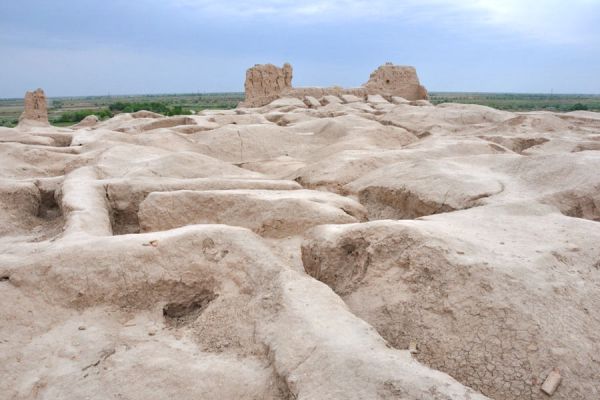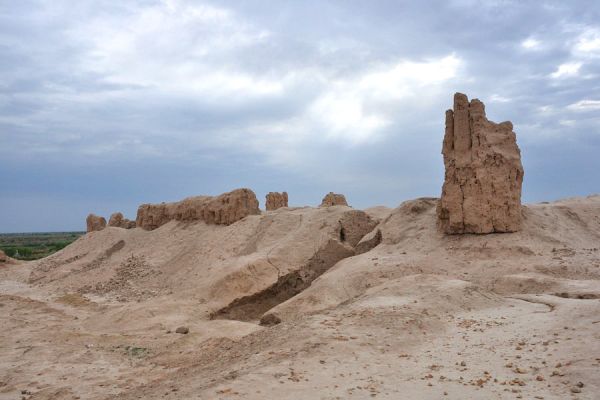Giaur-kala settlement
Mizdakhan is a complex of historical and archaeological sites located on three hills and the plain between them. The flat top of the western hill is crowned with the ruins of the Giaur-Kala fortress, built in the IV century BC and protecting the peace and quiet of a large city that once existed on the eastern hill. Scientists identify Mizdakhan with the city of Mazda mentioned in the holy book of the Zoroastrians "Avesta", built in honor of the main fire-worshipping deity Ahura Mazda. And now the eastern hill is occupied by the oldest necropolis in Central Asia. It stretches over an area of about 100 hectares, and its age, according to historians, is more than two thousand years old. There are many ossuaries on the hillsides – clay containers of bones of deceased Zoroastrians. A rich burial in a ceramic sarcophagus was also discovered here, and some ossuaries contained ritual items made of gold, religious symbols, and inscriptions in the ancient Khorezm language. Most of the ossuary burial ground is covered by a Muslim necropolis, and its first burials appeared immediately after the conquest of Khorezm by the Arabs.
An unusual semi-underground mausoleum of Muzlumkhan-sulu was built on the top of the eastern hill in the 12th-13th centuries. According to legend, it contains the ashes of the daughter of the ruler of Khorezm, the beautiful Muzlumkhan. The richest and noblest suitors sought her hand, but she fell in love with a simple architect. The Khan agreed to give her to him as a wife if he built a minaret as high as the sky in one night. The architect in love fulfilled this condition, but the treacherous khan broke his promise, and the young man rushed down from the tower, which he built himself, and the princess rushed after him. The khan ordered the minaret to be destroyed, and the lovers to be buried together, building a mausoleum of minaret bricks over their graves.
Only the domes and the entrance portal to the Muzlumkhan-sulu mausoleum rise above the surface of the earth. Through a vaulted corridor, a stone staircase leads down into a small domed room, along which you can descend even lower into the central hall and through the passages get into semi-dark small rooms covered with octagonal domes. It is cool here in the forty-degree heat, and the sunlight coming from the windows cut through the central dome illuminates the blue mosaics on the walls and vaults of the tomb.
There are two tombstones in the niches of the central hall, lined with blue and white tiles with gilding. The Arabic epitaphs on the tombstones, written in Naskh, contain lines from the Koran, but neither the names of the buried nor the dates of their deaths are indicated.
One hundred and twenty meters south of the tomb of Mazlumkhan-sulu are the ruins of the most mysterious building on Mizdakhan, known as the mausoleum of Yerezhep Khalifa. According to legend, a saint who preached Islam at the dawn of its spread in these places is buried here. However, many believe that Adam's grave is located here. However, scientists believe that this burial site is identified with the tomb of Gayomard, the first man on Earth from Zoroastrian mythology. But this is not the only reason why Yerezhep's mausoleum has become a place of pilgrimage for people from all over the world. Archaeological studies have shown that the building, erected in the 9th–10th centuries, has a solid foundation based on a reed layer that protects the structure from groundwater and gives it earthquake resistance. However, only three of its walls and the remains of the dome have survived to our time. Only a part of the masonry remains of the facade where the portal was located, and a pile of burnt polished bricks lies at the entrance. There is an ancient legend dating back to pre-Islamic times that there is a "world clock" here that measures the time of humanity's existence. Every year, one brick falls from the walls of this building, and when the last one falls, the end of the world will come, and life on Earth will run out. The pilgrims, asking fate for the fulfillment of their cherished desires, built thousands of small pyramids around the tomb from fallen bricks stacked on top of each other. The number of bricks in a pyramid must necessarily be seven, it is not customary to take bricks from someone else's pyramid, because destroying other people's hopes will not build your own happiness. It is considered a sin to take at least one brick from Mizdakhan with you. No one saw when and how the bricks fell from the mausoleum wall, and no one counted the remaining ones in the masonry.
Mystically, the magic of the number "seven" is also connected with the mazar of the legendary magician Shamun-nabi, which is located on the northern hill of Mizdakhan. Saint Shamun is said to have performed miracles, cured diseases, controlled the weather and the movement of the heavenly bodies, understood the language of animals and preached faith in One God. The mausoleum of Shamun-nabi was built in the XVIII century on the ruins of an ancient structure. Inside the tomb with a high portal and seven domes is a tombstone more than twenty-five meters long, but when archaeologists opened the tomb, no remains were found there.
Next to the Shamun-Nabi mazar there is a mound about five meters high, which allegedly appeared over the grave of Saint Jumart. There is a belief that a woman who wants to be cured of infertility must roll off Jumart hill, turning over her head seven times.
The mysticism of the "world clock" and the magic of numbers, history and folk legends are closely intertwined on the legendary hills of Mizdakhan, which are equally attractive to pilgrims and scientists, lovers of antiquities and tourists.






















